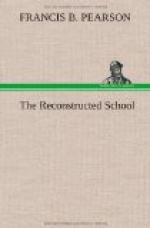A close scrutiny will convince even the most incredulous that many teachers and schools arc doing their utmost, in actual practice if not in theory, to eliminate the ten per cent margin and render their pupils imitators to the full one hundred per cent limit. We force the children to travel our standard pedagogical tracks and strive to fashion and fix them in our standard pedagogical molds. And woe betide the pupil who jumps the track or shows an inclination to travel a route not of the teacher’s choosing! He is haled into court forthwith and enjoined to render a strict accounting for his misdoing; for anything that is either less or more than a strict conformity to type is accounted a defection. We demand absolute obedience to the oracular edicts of the school as a passport to favor. Conformity spells salvation for the child and, in the interests of peace, he yields, albeit grudgingly, to the inevitable.
In world affairs we deem initiative a real asset, but one of the saddest of our mistakes in ordering school activities consists in our fervid attempts to prove that the school is detached from life and something quite apart from the world. We would have our pupils believe that, when they are in school, they are neither in nor of the world. At our commencement exercises we tell the graduates that they are now passing across a threshold out into the world; that they are now entering into the realms of real life; and that on the morrow they will experience the initial impact of practical life. These time-worn expressions pass current, at face value, among enthusiastic relatives and friends, but there are those in the audience who know them to be the veriest cant, with no basis either in logic or in common sense. It is nothing short of foolishness to assert that a young person must attain the age of eighteen years before he enters real life. The child knows that his home is a part of the world and an element in life, that the grocery is another part, the post-office still another part, and so on through an almost endless list. Equally well does he know that the school is a part of life, because it enters into his daily experiences the same as the grocery and the post-office. Full well does he know that he is not outside of life when he is in school, and no amount of sophistry can convince him otherwise. If the school is not an integral part of the world and of life, so much the worse for the school and, by the same token, so much the worse for the teacher. Either the school is a part of the world or else it is neither a real nor a worthy school.




